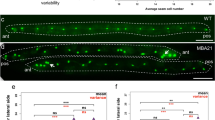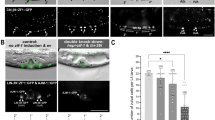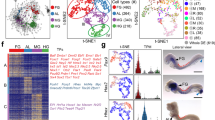Abstract
TWO types of developmental events can cause an embryonic cell to adopt a fate different from that of its neighbours: during a cell division particular contents may be segregated to only one daughter cell and cells may experience different external cues, commonly in the form of inductive cell interactions. Work on development in the nematode Caenorhabditis elegans suggests that most cell fates are specified without a need for cell interactions. In particular, the gut cell lineage of C. elegans has been used as a primary example of specification by differential segregation of determinants1. Here I re-examine the role of induction in gut specification by isolating early blastomeres. In C. elegans, the gut derives from all the progeny of a single blastomere (E) of the eight-cell stage2. When a gut precursor cell (EMS) is isolated during the first half of the four-cell stage, gut does not differentiate. Gut differentiation is rescued by recombining EMS with its posterior neighbour (P2), but not by recombining EMS with one or both of the other two cells of the four-cell stage. These results demonstrate that P2 induces EMS to form gut in C. elegans.
This is a preview of subscription content, access via your institution
Access options
Subscribe to this journal
Receive 51 print issues and online access
$199.00 per year
only $3.90 per issue
Buy this article
- Purchase on Springer Link
- Instant access to full article PDF
Prices may be subject to local taxes which are calculated during checkout
Similar content being viewed by others
References
Davidson, E. H. Gene Activity in Early Development 3rd edn (Academic, Orlando, 1986).
Sulston, J. E. et al. Devl Biol. 100, 64–119 (1983).
Schierenberg, E. Devl Biol. 122, 452–463 (1987).
Priess, J. R. & Thomson, J. N. Cell 48, 241–250 (1987).
Laufer, J. S. et al. Cell 19, 569–577 (1980).
Edgar, L. G. & McGhee, J. D. Devl Biol. 114, 109–118 (1986).
Maine, E. M. & Kimble, J. BioEssays 12, 265–271 (1990).
Wood, W. B. Nature 349, 536–538 (1991).
Scbnabel, R. Mech. Dev. 34, 85–100 (1991).
Laufer, J. S. & von Ehrenstein, G. Science 211, 402–405 (1981).
Sulston, J. & Hodgkin, J. in The Nematode Caenorhabditis elegans (ed. Wood, W. B.) 587–606 (Cold Spring Harbor Laboratory Press, New York, 1988).
Chitwood, B. G. & Chitwood, M. B. Introduction to Nematology (University Park, Baltimore, 1974).
Author information
Authors and Affiliations
Rights and permissions
About this article
Cite this article
Goldstein, B. Induction of gut in Caenorhabditis elegans embryos. Nature 357, 255–257 (1992). https://doi.org/10.1038/357255a0
Received:
Accepted:
Issue Date:
DOI: https://doi.org/10.1038/357255a0
This article is cited by
-
The C. elegans intestine: organogenesis, digestion, and physiology
Cell and Tissue Research (2019)
-
The study of Priapulus caudatus reveals conserved molecular patterning underlying different gut morphogenesis in the Ecdysozoa
BMC Biology (2015)
-
Spatiotemporal transcriptomics reveals the evolutionary history of the endoderm germ layer
Nature (2015)
-
Molecular conservation of metazoan gut formation: evidence from expression of endomesoderm genes in Capitella teleta (Annelida)
EvoDevo (2014)
-
Actomyosin-based Self-organization of cell internalization during C. elegans gastrulation
BMC Biology (2012)
Comments
By submitting a comment you agree to abide by our Terms and Community Guidelines. If you find something abusive or that does not comply with our terms or guidelines please flag it as inappropriate.



